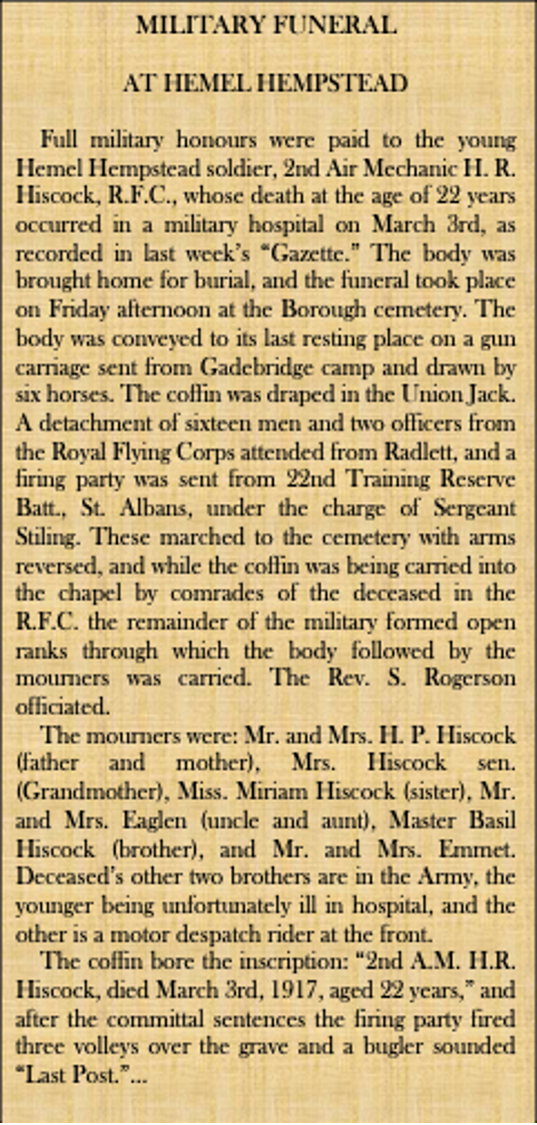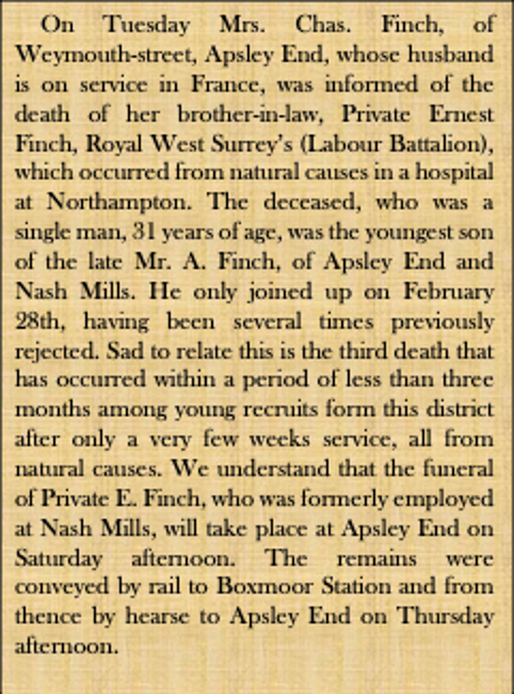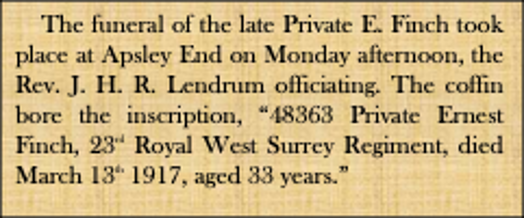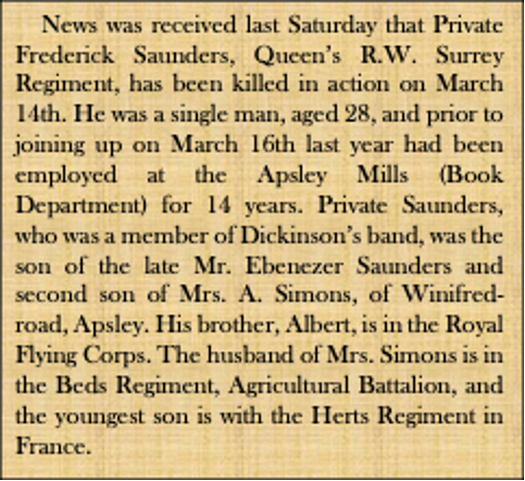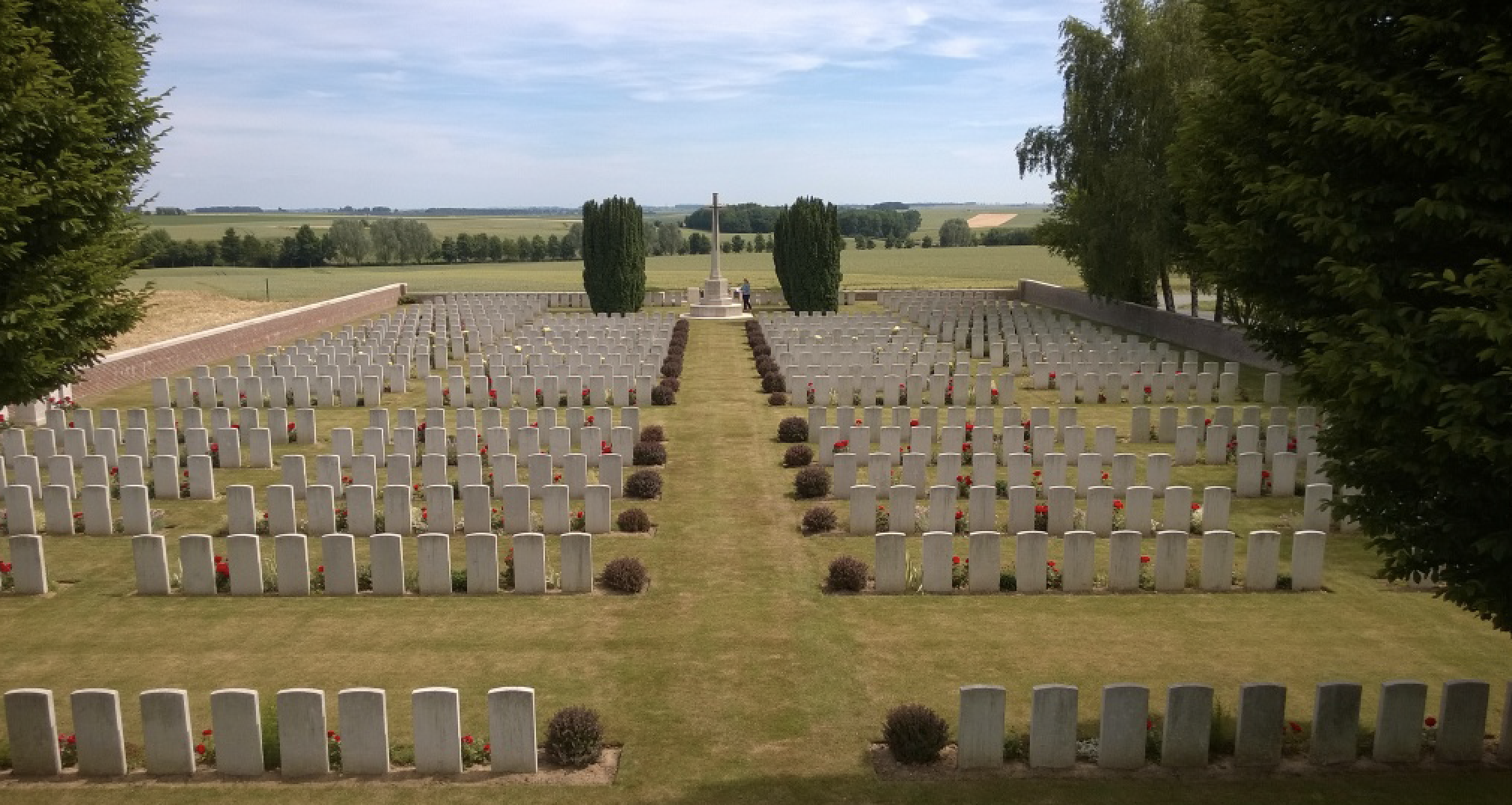Fallen in March 1917:
Harold Ronald Hiscock
Ernest Finch
Frederick Arthur Saunders
George Ambrose
HARRY RONALD HISCOCK
5656 Air Mechanic 2nd Class
Royal Flying Corps
Died of Illness Saturday, 3rd March 1917
Remembered with Honour, Hemel Hempstead (Heath Lane) Cemetery, Hertfordshire, United Kingdom, Grave W.21
Harry Ronald Hiscock, known as Ron, was born in Wandsworth in London on Thursday, 2nd August 1894, the oldest child of Harry Philip Hiscock and Florence Charlotte Walters. Harry and Florence had five other children who were; Victor, Miriam, Hubert, Basil and Alice. Two of Ron’s brothers, Victor and Hubert also fought in the Great War and both survived the conflict.
Ron’s father Harry had been a ‘Commercial Clerk’ before he married Florence Walters in Croydon in 1893, after which the newly-weds moved to Wandsworth where Harry set up as a ‘Cycle Maker’. Three years after Ron was born, his family moved to Aylesbury where his father opened a bicycle shop and where his sister Miriam and brother Hubert were born.
Finally, in around 1900 the Hiscock family arrived in Hemel Hempstead where they took up residence in ‘Clifton Villas’ on Bridge Street, and Harry set up his cycle shop at 82 Marlowes. The shop eventually expanded to number 80 next door and traded until Harry’s death in 1926 selling not only bicycles but rather curiously, ‘Gramophones’.
Ron and his younger brother Victor started school on 26th May 1902 when they entered Boxmoor JMI school which recorded that both boys had been privately educated before their arrival. The brothers did not stay long at Boxmoor school and when there had consistently irregular attendance. The school log recorded that the Attendance Officer often visited the school because of their absence. Francis St. John Badcock, the head teacher, noted his own observations in the log revealing that he felt they were evading the ‘Act’ (the Education Act which set out compulsory attendance and the school leaving age).
Ron and Victor left Boxmoor JMI in 1904 to go to a ‘Private’ school, and by 1911 they were both employed as ‘Assistants’ by their father in his shop on the Marlowes. The family lived at ‘Gladstone Villas’ on Crescent Road not far from Midland Station, and on the outbreak of war twenty-year-old Ron went from there to enlist.
The report of his death in the Hemel Gazette stated that he made several attempts to join the Colours but was rejected each time, presumably because of his health or fitness. His efforts continued for two more years before Ron successfully passed all the tests to become an Air Mechanic, and in early February 1917 he joined the Royal Flying Corps.
Sadly, his service was short-lived when in mid-February he caught a chill which turned to influenza and resulted in his admission to hospital. He was there for two weeks until he succumbed to the illness, only five weeks after his entry into the Army. (see extract)
Ron died on Saturday, 3rd March 1917.
His body was brought home to Hemel Hempstead and he was given a full military funeral and buried in Heath Lane Cemetery on Friday, 16th March 1917. A report of Ron’s funeral was published in the Hemel Gazette on the following day. (see extract)
Ron is Remembered with Honour in Hemel Hempstead (Heath Lane) Cemetery, Hertfordshire, United Kingdom where he is interred in Grave W.21. The inscription on his headstone, requested by his mother Florence, reads: “ONLY "GOOD NIGHT" BELOVED NOT FAREWELL”.
He was 22 years old when he died.
Ron was entitled to the British War Medal and the Allied Victory Medal.
Hiscock's advertisement (Image: Hemel Hempstead Gazette and West Herts Advertiser)
Extract from The Hertfordshire, Hemel Hempstead Gazette and West Herts Advertiser 10th March 1917
Extract from The Hertfordshire, Hemel Hempstead Gazette and West Herts Advertiser 17th Mar. 1917
Ron's headstone, Heath Lane Cemetery, Hemel Hempstead (Photo: Traquair Photography)
ERNEST FINCH
48363 Private
The Queen's (Royal West Surrey Regiment)
Died of Natural Causes Tuesday, 13th March 1917
Remembered with Honour, Apsley End (St. Mary) Churchyard, Apsley, Hertfordshire, United Kingdom, Grave NE Churchyard
Ernest Finch was born in Nash Mills near Apsley End, Hertfordshire on Friday, 16th January 1885. He was the youngest child born to Alfred Finch and Elizabeth Cheshire Martha who had a total of nine children together. The children were: William, Mary Ann, Harry, Charles, Alfred, Emily, Arthur, Walter and Ernest.
Ernest’s family lived in Nash Mills when he was born, before moving to 89 Cotterells in Hemel Hempstead in the early 1890s. His father and older brother Charles worked as ‘Gardeners’ at Nash House, the original home of John Dickinson in Apsley.
Ernest started his education at Nash Mills school before moving to Boxmoor JMI in March 1895. He was at the school for just a year before moving to Apsley Boys school where his education was completed in 1898. On leaving, he started work with John Dickinson & Co Limited in Apsley Mills.
By 1901 the Finch family had moved to ‘Ashleigh Villas’ on Weymouth Street in Apsley where Ernest would remain until he joined the Colours and went to war. His mother Elizabeth had died at the age of sixty-one in 1899, and his widowed father Alfred lived with Ernest and another son Charles and Charles’ wife Alice.
Ten years later the only change to these living arrangements was the presence of Ernest’s five young nephews and nieces in the small terraced home. His father Alfred died in 1915 aged eighty-five, leaving Ernest at home with his brother Charles, sister-in-law Alice and their young family.
After war had broken out Ernest attempted to enlist, but was rejected on several occasions until finally, on the 28th February 1917, he was at last successful and joined the Queen's (Royal West Surrey Regiment) at Watford.
Less than two weeks after joining up he caught a chill and when his condition quickly deteriorated he was admitted to the Duston Military Hospital at Upton in Northampton. The hospital had previously been the Berrywood Asylum, but on the outbreak of war it was handed over as a military hospital and covered East Anglia and the East Midlands.
Ernest’s chill had turned to pneumonia and only days after his admission to hospital he sadly died on Tuesday, 13th March 1917.
His death and funeral were reported in the Hemel Gazette in the days following his death. (see extract)
His funeral service was conducted by the Rev. J.H.R Lendrum who would be killed in August 1918. His biography also appears on this site.
He is commemorated on a memorial plaque in St Mary’s Church, Apsley End.
Ernest is Remembered with Honour in Apsley End (St. Mary) Churchyard, Apsley, Hertfordshire, United Kingdom, where he is interred in Grave NE Churchyard.
He was 32 years old when he died.
Ernest was entitled to the British War Medal and the Allied Victory Medal.
Extract from The Hertfordshire, Hemel Hempstead Gazette and West Herts Advertiser 17th Mar. 1917
Extract from The Hertfordshire, Hemel Hempstead Gazette and West Herts Advertiser 17th Mar. 1917
Memorial Plaque, St Mary’s Church, Apsley End (Photo: Traquair Photography)
Ernest's headstone, Heath Lane Cemetery, Hemel Hempstead (Photo: Traquair Photography)
FREDERICK SAUNDERS
21059 Private
2nd Bn., The Queen's (Royal West Surrey Regiment)
Killed in Action Wednesday, 14th March 1917
Remembered with Honour, Queens Cemetery, Bucquoy, Pas-de-Calais, France, Grave II. A. 4.
Frederick Arthur Saunders, known as Fred, was born in Eaton Bray in 1889. He was the youngest of four children born to Ebenezer and Mary Saunders, both natives of Eaton Bray and their children were: Jane, Rose, Albert and Fred. Fred’s father died sometime around 1896 and his mother remarried in Leighton Buzzard two years later to Albert Simons. Albert was twelve years Mary’s junior, but he took on her young family and he and Mary soon had two children of their own; Arthur John and Percy, Fred’s half-brothers.
Fred’s older brother Albert fought in the Great War with the Royal Flying Corps and his younger half-brother Arthur served with the Hertfordshire Regiment, both surviving the conflict. His step-father Albert was with the Agricultural Battalion of the Bedfordshire Regiment and worked on farms in place of younger men who had gone to fight.
When Fred’s mother remarried the family moved to Apsley End with their new step-father and lived at 1 Winifred Road in the village. The family would remain at this address for almost forty years and even when Albert and Mary moved, it was just across the road to number 12 where they stayed until their deaths in the mid-1940s.
After leaving school in 1902, Fred joined John Dickinson & Co. Limited at Apsley Mills in the Book Department where both he and his brother Albert worked as ‘Book Binders’. By 1911, his step-father Albert, sister Jane, brother Albert and Fred all worked at Apsley Mills, whilst his mother Mary was a ’Church Caretaker’. This may have been at St Mary’s in Apsley End where the family were all members of the congregation.
While he worked at John Dickinsons, Fred was a member of the Factory Band which had been formed in 1894 as ‘Dickinson Brass Band’. In 1899 it was renamed ‘Dickinson Silver Band’ and it then continued under various names, formations and amalgamations until the present day and what is now the Hemel Hempstead Band.
By the time he was called up, Fred had worked at Dickinsons for fourteen years and on the 16th March 1916 he attested at Hemel Hempstead and joined the Colours. He enlisted with the Suffolk Regiment but by the time he went to France he had been transferred to the 2nd Battalion The Queen's (Royal West Surrey Regiment).
Research has not revealed exactly when Fred left for the Front, but it is likely to have been in September or October 1916. By the following February, Fred was with the 2nd Battalion near Bucquoy north of Albert in support of actions undertaken by the 91st Brigade. On the 13th March the 2nd West Surreys reconnoitred the enemy positions in Bucquoy trench and reported that these were strongly fortified with machine gun posts at twenty-five-yard intervals, except for one weak area. Orders were given to attack at this point on the following day and at ‘zero hour’ on the 14th March the attack began under a light enemy barrage. The war diary records that "Owing to a light rain and the heavy state of the ground the men had great difficulty getting along or keeping their feet and when they fell their rifles became choked up with mud."
Despite the conditions some small progress was achieved, but two hours later by 3 a.m. it became clear that further progress was impossible and the orders to withdraw were given. The withdrawal was completed within a further two hours. The diary does not document the details of the casualties in this action, but it is officially recorded that Fred was ‘Killed in Action’ on the 14th March 1917. He died almost a year to the day following his enlistment in the Army.
His death was reported in the Hemel Gazette a month later. (see extract)
Extract from The Hertfordshire, Hemel Hempstead Gazette and West Herts Advertiser 14th Apr. 1917
John Dickinson & Co Limited War Memorial Apsley (Photo: Traquair Photography)
St Mary’s Church War Memorial plaque, Apsley End (Photo: Traquair Photography)
Queens Cemetery, Bucquoy, Pas-de-Calais, France (Photo: CWGC)
He was commemorated on the John Dickinson & Co. Limited war memorial in Apsley and on the memorial plaque in St Mary’s Church, Apsley-End.
Fred is Remembered with Honour in Queens Cemetery, Bucquoy, Pas-de-Calais, France where he is interred in Grave II. A. 4. The inscription on his headstone, requested by his mother Mary, reads: “IN LOVING MEMORY OF MY DEAR SON REST IN THE LORD”
He was 28 years old when he died.
Fred was entitled to the British War Medal and the Allied Victory Medal.
GEORGE AMBROSE
201148 Private
4th Bn., Essex Regiment
Killed in Action Tuesday, 27th March 1917
Remembered with Honour, Jerusalem Memorial, Israel and Palestine, Panels 32 to 38
George Ambrose was born in Hemel Hempstead in late 1891 the third child of Thomas Ambrose and Elizabeth Jane Tripp. Thomas and Elizabeth had two other children together, a daughter Daisy and another son Thomas. Georges’ father had been married before to Rebecca Ann Lane but sadly, Rebecca had died whilst giving birth to their son Sydney in 1881. His father married for a third time following the death of George’s mother Elizabeth in 1891 and with his third wife Annie Maria Sansom, Thomas had seven more children. George’s half siblings were: William, Edith, Lily, Amy, Florrie, Ethel and Leonard who was born in 1907 just a year before George’s father died aged fifty-two.
The family lived on Bury Road in Hemel Hempstead when George was born, and his father worked as a ‘Tanner’s Labourer’ in Henry Balderson’s tannery at Corner Hall. He progressed to a more skilled aspect of tanning and worked as a ‘Hide Dresser’ in 1901 when the growing family was still at 34 Bury Road.
By the time George was nineteen in 1911 he had moved away from Bury Road and was boarding in the Brewers Arms pub at 76 & 78 High Street, Hemel Hempstead, with Mrs Emma Pitkin the landlady. There were ten men boarding at the pub and eight of them, including George, were working as ‘Labourers’ with a threshing machine on farms in the area. The Brewers Arms continued as a boarding house and pub until the 1960’s before closing.
George enlisted in March 1915, attesting at Hemel Hempstead and joining the Bedfordshire Regiment. He transferred shortly afterwards to the 1/4th Battalion Essex Regiment which had been based at St Alban’s, prior to embarking for Gallipoli in July 1915. When his basic training was completed, George followed the Battalion to Palestine in late 1915 and would remain there for the rest of his service.
Throughout 1916 George was with his comrades as part of the 54th (East Anglian) Division as it occupied No 1 (Southern) Section of the Suez Canal defences. However, changes came in 1917 when the 1/4th Essex Battalion fought in the First Battle of Gaza.
The coastal city of Gaza was the heart of the main Turkish defensive position in southern Palestine and this was the site of first Battle of Gaza on the 26th March 1917. Two British infantry divisions attacked from the south while the mounted troops of the Desert Column attacked from the flanks and north. When the attack was launched, the infantry made slow progress, but the mounted troops succeeded in capturing high ground to the north of the city and advancing into it. Concerned by the lack of progress made by the infantry, and fearing the water supplies vital for the mounted troops would not be captured that night, Lieutenant General Dobell, the British officer commanding the operation, ordered a withdrawal at dusk. The next morning, after realising his mistake, Dobell attempted to resume the battle with the infantry, but with the troops exhausted and the Turks having received reinforcements, the attack floundered.
The casualties incurred during the action were high on both sides and it was at some time on the 26th or 27th that George was killed. He was officially recorded ‘Killed in Action’ on Tuesday 27th March 1917.
The Brewers Arms "below the railings" on High Street, Hemel Hempstead c 1906 (Photo: http://www.hertfordshire-genealogy.co.uk)
Situation Map, First Battle of Gaza, March 1917 (Image: Public Domain)
Jerusalem Memorial, Israel and Palestine (Photo: CWGC)
George is Remembered with Honour on the Jerusalem Memorial, Israel and Palestine, Panels 32 to 38
He was 25 years old when he died.
George was entitled to the British War Medal and the Allied Victory Medal.

